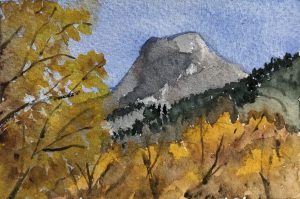BY LESLIE REGO

The Industrial Revolution (1760–1840) created a rising middle class with more leisure time than ever before. During this time period one of the most beloved hobbies, especially in Britain, was watercolor. Watercolors up to 1848 had to be ground and mixed from hard cakes, something only professional artists would attempt. But in 1848, the lead tube was invented, which allowed premixed watercolors to be kept moist within the tube. For the first time, anyone could easily use watercolors.
In 1856, John Ruskin (1819–1900), a British writer and artist, wrote “The Elements of Drawing.” Men and women, without going to art school or studying with an art master, could acquire the tools to learn how to draw. The book became a bestseller! Copies were sold throughout the British Empire, from India to Africa to Australia, Canada and even China.
Many people adopted a sketchbook practice. There were sketchbook forays into the countryside to draw daily events, at times adding a poem alongside the drawing. Natural and political events were commemorated within the sketchbook pages. Human frailties were sketched. Soldiers took sketchbooks into the trenches during World War I and World War II.
And that brings me to my own sketchbook practice. I love my sketchbook. It is my companion during my many hours spent with nature. If my day has been arduous and cold, my sketchbook is an intimate partner sharing this discomfort. If I have a transcendental hike, like I recently had hiking in the Pioneer Mountains, my sketchbook reflects those spiritual moments.
The artist within me and my sketchbook were put to the test during my latest hike to Boulder Lake. The views were big and the woods were intimate. The hike is an eight-mile round trip with a 2200-foot elevation gain. The trail starts steep, passing through old Douglas fir trees with enormous trunks and majestic branches, and then it levels off a bit, meandering alongside a creek, through meadows, crossing over small waterfalls and rapids until you come out to a boulder-filled meadow that leads to the lake.
Magnificent vistas are in every direction. Views of the Devil’s Bedstead play peekaboo through the trees and around the bends. I kept asking myself, are there enough tubes of paint, enough sketchbooks or enough paper to show it all?
I thank Ruskin for his expertise. Much of what I have learned has come from “The Elements of Drawing.” Even though there are not enough superlatives to adequately describe the hike to Boulder Lake, I believe the ethereal moments I spent on the trail will stay immortalized through my sketchbook.
Leslie Rego is an Idaho Press Club award-winning columnist, artist and Blaine County resident. To view more of Rego’s art, visit leslierego.com.


